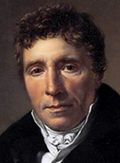 |
Emmanuel-Joseph Sieyès
b. 3 May 1748, Fréjus, Var
d. 20 Jun 1836, Paris |
| Title: |
Membre du Directoire exécutif de la République française (Member of the Executive Directory of the French Republic) |
| Term: |
20 May 1799 - 10 Nov 1799 |
| Chronology: |
11 May 1799, 12 May 1799, 13 May 1799, ten candidates for election of a member of the Directoire exécutif (Executive Directory) nominated by the Conseil des Cinq-Cents (Council of Five Hundred) and the list passed to the Conseil des Anciens (Council of Ancients) [1; 2; 3] |
|
16 May 1799, elected, session of the Council of Ancients, salle des Machines, Palais des Tuileries, Paris [4; 5] |
|
20 May 1799, term commenced according to the Law of 15 ventôse, Year VI |
|
8 Jun 1799, assumed the functions of office, session of the Executive Directory, Palais du Luxembourg, Paris [6] |
|
10 Nov 1799, Executive Directory recognized as not existing, Law of 19 brumaire, Year VIII, passed by the Council of Ancients, galerie d'Apollon (grande galerie), Palais de Saint-Cloud, Saint-Cloud |
| Names/titles: |
Surname also spelled as: Siéyès; comte Sieyès, comte de l'Empire (count Sieyès, count of the Empire) [from 3 Jun 1808] |
|
Président de l'Assemblée nationale (President of the National Assembly) (8 Jun 1790 - 21 Jun 1790) [see details]; Président de la Convention nationale (President of the National Convention) (20 Apr 1795 - 5 May 1795) [see details]; Président du Directoire exécutif de la République française (President of the Executive Directory of the French Republic) (19 Jun 1799 - 23 Sep 1799) [see details]; Consul de la République française (Consul of the French Republic) (10 Nov 1799 - 25 Dec 1799) [see details] |
| Biography: |
| Originated from a notary family of Fréjus; educated for an ecclesiastical career at the Doctrinaires' college in Draguignan; attended the seminaries of Saint-Sulpice (1765-1770) and Saint-Firmin (1770-1772) in Paris; was made a secretary to Jean-Baptiste-Joseph de Lubersac, bishop of Tréguier, Brittany (1775); accepted a canonry at Tréguier (1779); followed Lubersac who had been transferred to the bishopric of Chartres (1780); became a canon of the cathedral (1783) and chancellor of the diocese of Chartres (1788); appointed a commissioner at the Sovereign Chamber of Clergy of France (1787-1790); served as a member of provincial assembly of Orléans (1787); issued pamphlet Qu'est-ce que le tiers état? (1789), identifying the unprivileged Third Estate with the French nation; elected (19 May 1789) as a representative of the Third Estate by the constituency of Paris to the États-Généraux (Estates-General); was one of the initiators of declaring the Estates-General an assembly of representatives of the French people (15 Jun 1789); deputy of the Assemblée nationale (National Assembly) (1789-1791); served as President of the National Assembly (8 Jun 1790 - 21 Jun 1790); elected to Convention nationale (National Convention), representing the département of Sarthe (1792-1795); voted for the execution of King Louis XVI; served as a member of the Comité de salut public (Committee of Public Safety) (5 Mar 1795 - 3 Jul 1795, 2 Aug 1795 - 4 Nov 1795); elected President of the National Convention (20 Apr 1795 - 5 May 1795); elected (15 Oct 1795) to the Corps législatif by 19 départements, opted for Sarthe; selected for sitting in the Conseil des Cent-Cents (Council of Five Hundred); elected (1 Nov 1795) a member of the Directoire exécutif (Executive Directory), but declined (2 Nov 1795); survived an assassination attempt (12 Apr 1797); President of the Council of Five Hundred (21 Nov 1797 - 21 Dec 1797); appointed (10 May 1798) ambassador to the Kingdom of Prussia; elected a member of the Executive Directory for the second time (16 May 1799) to replace Jean-François Reubell; returned to Paris (7 Jun 1799) and assumed his seat (9 Jun 1799); served as President of the Directory (19 Jun 1799 - 23 Sep 1799); conspiring with Napoléon Bonaparte, helped organize the 18 Brumaire coup (9 Nov 1799 - 10 Nov 1799) that overthrew the Directory; appointed Consul of the Republic (10 Nov 1799 - 25 Dec 1799) along with Bonaparte and Pierre-Roger Ducos; drafted the Constitution of Year VIII; nominated member of the Sénat conservateur (ex officio as the outgoing consul according to Art. 24, Constitution of Year VIII, effective 25 Dec 1799); served as President of the Sénat conservateur (25 Dec 1799 - 25 Mar 1800); nominated grand officer of the Legion of Honour (14 Jun 1803), count of the empire (3 Jun 1808); nominated to the Chambre des pairs (Chamber of Peers) (2 Jun 1815) during the Cent-Jours (Hundred Days); banished as a regicide (1815) and did not return to France until 1830.
Biography source: [7] |
| Elections: |
| Candidate |
Vote (16 May 1799) |
| Emmanuel-Joseph Sieyès |
118 |
| Jean-Pierre Duval |
74 |
| Louis-Jérôme Gohier |
7 |
| Charles-Joseph-Mathieu Lambrechts |
5 |
| Charles Delacroix de Contaut |
1 |
| Pierre-François-Joseph Lefebvre |
0 |
| Jean-Baptiste-Raymond Lacrosse |
0 |
| Jean-François-Auguste Moulin |
0 |
| Pierre Martin |
0 |
| Charles-François Dupuis |
0 |
| total votes cast |
205 |
|
| Information source: [4; 5]
|
| |
| [1] |
Gazette nationale ou Le Moniteur universel, No. 234, 24 floréal an VII. |
| [2] |
Gazette nationale ou Le Moniteur universel, No. 235, 25 floréal an VII. |
| [3] |
Gazette nationale ou Le Moniteur universel, No. 237, 27 floréal an VII. |
| [4] |
Gazette nationale ou Le Moniteur universel, No. 241, 1 prairial an VII. |
| [5] |
Bulletin des lois de la République, No. 279, pp. 31-32. |
| [6] |
Procès-verbaux du Directoire exécutif, 9:64. |
| [7] |
Dictionnaire des parlementaires français 1789-1889, |

